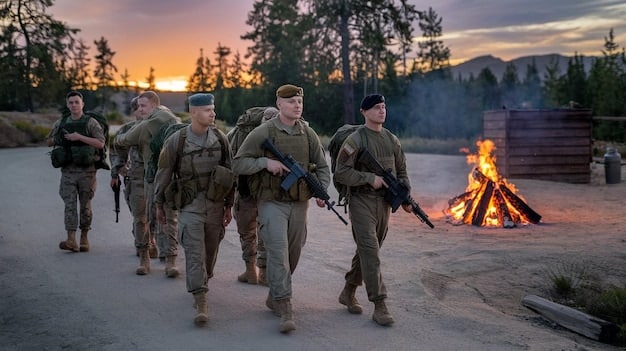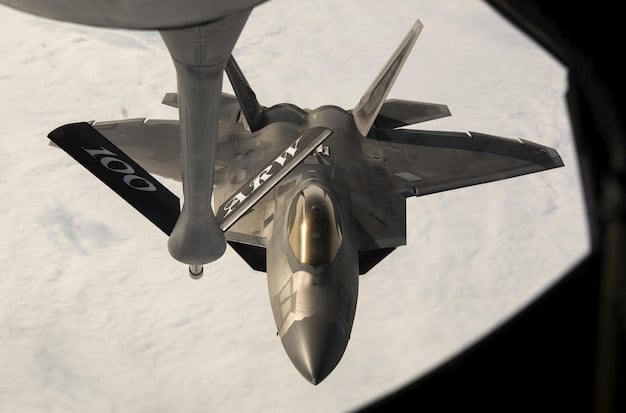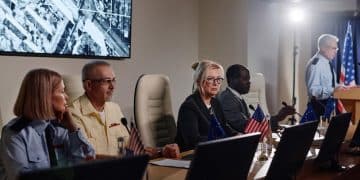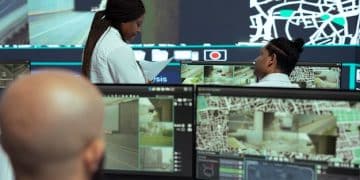US Military Readiness: Current Status & Future Challenges

US Military Readiness: Assessing Current Capabilities and Future Needs involves a thorough evaluation of the armed forces’ capacity to respond effectively to various threats, considering factors such as training, equipment, personnel, and strategic planning to ensure national security.
Understanding US Military Readiness: Assessing Current Capabilities and Future Needs is crucial to ensuring that the nation’s defense forces are prepared to address evolving threats and maintain global stability. This article aims to provide an in-depth look at the current state of the US military, its capabilities, and the challenges it faces.
Understanding US Military Readiness
Military readiness refers to the ability of a nation’s armed forces to perform their assigned missions. It encompasses various elements, including personnel, equipment, training, and leadership. Evaluating readiness is vital for ensuring national security and maintaining a credible deterrent force.
Assessing the readiness of the US military involves a comprehensive analysis of its capabilities and resources. This includes evaluating the condition of equipment, the proficiency of personnel, and the effectiveness of training programs.

Key Components of Military Readiness
Several key components contribute to the overall readiness of the US military. These include:
- Personnel Readiness: Ensuring that the armed forces have the required number of personnel with the necessary skills and qualifications.
- Equipment Readiness: Maintaining equipment in optimal condition and ensuring that it is up-to-date with the latest technological advancements.
- Training Readiness: Providing realistic and effective training programs that prepare personnel for a wide range of scenarios.
- Leadership Readiness: Developing strong and capable leaders who can effectively command and manage troops in both peacetime and wartime.
These components are interconnected and must be addressed holistically to achieve optimal military readiness.
In conclusion, understanding US military readiness requires a comprehensive evaluation of its key components and the challenges it faces. By addressing these issues, the US can ensure that its armed forces are prepared to meet the threats of today and tomorrow.
Current Capabilities of the US Military
The US military possesses a wide range of capabilities, making it one of the most powerful and technologically advanced armed forces in the world. These capabilities are distributed across various branches, including the Army, Navy, Air Force, Marine Corps, and Coast Guard.
Each branch has its own unique strengths and capabilities, contributing to the overall strength and readiness of the US military.
Overview of US Military Branches
The primary branches of the US military include:
- Army: Responsible for land-based military operations, including combat, peacekeeping, and humanitarian assistance.
- Navy: Responsible for maritime operations, including naval warfare, sea control, and maritime security.
- Air Force: Responsible for air and space operations, including air superiority, strategic bombing, and reconnaissance.
- Marine Corps: A combined arms force that can conduct both land and amphibious operations, often serving as the first responders in crisis situations.
These branches work together to provide a comprehensive defense capability for the United States.
The US military continues to invest in new technologies and training programs to maintain its competitive edge and ensure its ability to respond effectively to emerging threats.

Challenges to Maintaining Readiness
Despite its strengths, the US military faces several challenges in maintaining readiness. These challenges include budget constraints, aging infrastructure, and evolving threats.
Addressing these challenges is essential to ensure that the US military remains prepared to meet the demands of a complex and uncertain world.
Budget Constraints and Their Impact
Budget constraints can limit the ability of the US military to invest in new equipment, training programs, and personnel. This can lead to a decline in readiness and an increased risk of mission failure.
- Reduced Training Opportunities: Budget cuts may lead to fewer opportunities for realistic and effective training, which can impact personnel proficiency.
- Delayed Equipment Modernization: Limited funding can delay the modernization of equipment, leaving the military with outdated and less capable systems.
- Personnel Shortages: Budget constraints may force the military to reduce its personnel levels, which can strain existing resources and impact readiness.
Addressing these issues requires a balanced approach that prioritizes readiness while also ensuring fiscal responsibility.
Overcoming these challenges requires a sustained commitment to investing in the US military and addressing the underlying issues that affect readiness.
Future Needs for US Military Readiness
As the world continues to evolve, the US military must adapt to meet new challenges and maintain its competitive edge. This requires investing in new technologies, training programs, and personnel.
Preparing for the future is essential to ensure that the US military remains capable of defending the nation and its interests.
Investing in Emerging Technologies
Investing in emerging technologies, such as artificial intelligence, robotics, and cyber warfare capabilities, is crucial for maintaining a technological advantage over potential adversaries.
- Artificial Intelligence: AI can enhance decision-making, improve logistics, and automate tasks, freeing up personnel for other critical missions.
- Robotics: Robots can perform dangerous tasks, such as bomb disposal and reconnaissance, reducing the risk to human soldiers.
- Cyber Warfare Capabilities: Developing strong cyber defenses and offensive capabilities is essential for protecting critical infrastructure and disrupting enemy operations.
These technologies can transform the way the US military operates and enhance its ability to respond to a wide range of threats.
By embracing innovation and investing in new capabilities, the US military can maintain its readiness and ensure its ability to meet the challenges of the future.
The Role of Technology in Enhancing Readiness
Technology plays a critical role in enhancing military readiness by improving communication, situational awareness, and combat effectiveness.
Leveraging technology effectively is essential for ensuring that the US military remains at the forefront of defense capabilities.
Advancements in Communication Systems
Advancements in communication systems have greatly improved the ability of military personnel to communicate and coordinate their actions, even in remote and challenging environments.
These systems enable real-time information sharing, which can enhance decision-making and improve mission outcomes.
In conclusion, technology is a vital tool for enhancing military readiness and ensuring that the US armed forces remain prepared to meet the challenges of the future.
Strategic Planning and Readiness
Strategic planning is essential for ensuring that the US military is prepared to meet future threats and challenges. It involves identifying potential risks, developing strategies to mitigate those risks, and allocating resources effectively.
Effective strategic planning requires a long-term perspective and a willingness to adapt to changing circumstances.
Importance of Long-Term Vision
A long-term vision is essential for guiding the development of military capabilities and ensuring that the US armed forces remain prepared to meet future threats.
This vision should be based on a thorough understanding of global trends, emerging technologies, and potential adversaries.
Ultimately, strategic planning is a critical component of military readiness, ensuring that the US armed forces are prepared to meet the challenges of the future and defend the nation’s interests.
| Key Point | Brief Description |
|---|---|
| 💪 Personnel Readiness | Ensuring sufficient, skilled military personnel. |
| ⚙️ Equipment Readiness | Maintaining and modernizing military equipment. |
| 🎯 Training Readiness | Providing realistic and effective training programs. |
| 🚀 Technological Advancements | Investing in AI, robotics, and cyber capabilities. |
Frequently Asked Questions
▼
Military readiness refers to the ability of a nation’s armed forces to perform their assigned missions effectively and efficiently. It encompasses personnel, equipment, training, and leadership.
▼
Military readiness is crucial for ensuring national security, deterring potential adversaries, and responding effectively to crises and conflicts around the world. Preparedness saves lives and resources.
▼
The US military faces challenges such as budget constraints, aging infrastructure, evolving threats, and the need to adapt to rapid technological advancements. This affects training and deployment.
▼
Technology significantly enhances military readiness by improving communication, situational awareness, combat effectiveness, and the ability to respond to cyber threats through advanced systems.
▼
Strategic planning is vital for identifying potential risks, developing mitigation strategies, and allocating resources effectively, ensuring the US military is prepared for future threats. It promotes efficiency.
Conclusion
In conclusion, maintaining US Military Readiness: Assessing Current Capabilities and Future Needs is an ongoing process that requires a comprehensive approach encompassing personnel, equipment, training, and strategic planning. Addressing the challenges and investing in future capabilities are essential to ensuring the nation’s defense and maintaining global stability.





